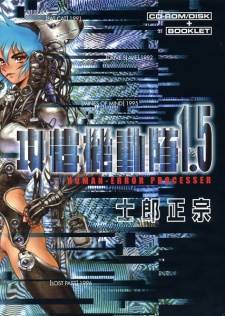I'll be concise here.
The original Ghost in the Shell manga is a true gem in the world of manga, philosophy and cyberpunk.
1.5 is a set of stories that didn't make it to either the original or 2, and were released after 2.
This one doesn't have the same amount of speculative content as the original, and its short, independent cases are less memorable.
The charismatic Major is almost entirely absent. Togusa, Batou and Aramaki get the spotlight.
The absence of an overarching plotline is one of the biggest weaknesses here. Further, there is only one major philosophical theory that Masamune appears to be presenting throughout the
...
Alternative TitlesSynonyms: Ghost in the Shell 1.5: Human-Error Processor Japanese: 攻殻機動隊1.5 HUMAN-ERROR PROCESSER More titlesInformationType: Manga
Volumes: 1
Chapters: 7
Status: Finished
Published: 1991 to Jul 15, 1996
Demographic:
Seinen
Serialization:
Young Magazine (Weekly) Authors:
Shirow, Masamune (Story & Art) Statistics Ranked: #47922 2 based on the top manga page. Please note that 'R18+' titles are excluded. Popularity: #2480
Members: 8,887
Favorites: 67 Resources | Reviews
Filtered Results: 3 / 3
Sort
Your Feelings Categories Dec 22, 2009
Sometimes more of the same is exactly what you want and the best you can hope for. Ghost in the Shell 1.5: Human-Error Processor proves that that is sometimes good, sometimes bad.
Things have settled down in Section 9 since the Puppeteer case ended. Major Motoko Kusanagi has disappeared. Batou has stepped up to fill her role as assault leader. Togusa is now partnered with the sharp-nosed Azuma, their newest recruit. The rest of Section 9’s crack team remains as quick-witted and kick-ass as ever. We open the story in the middle of a new case involving a cyber-criminal disturbingly similar to the Puppeteer. Someone has hijacked ... Aug 15, 2020
Before I talk about my thoughts on 1.5, I need to clarify that I am a huge fan of Ghost in the Shell, so I may have put a bit too much of my thoughts into some categories.
Ghost in the Shell 1.5: Human-Error Processor is the 3rd part of the GITS trilogy, so if you haven't read the first two [I'll say why reading GITS 2 is worth it in a little], I'd recommend doing so before reading this one. The manga should be read in this order: Ghost in the Shell -> Ghost in the shell 2: Man-Machine Interface -> Ghost in the Shell ... |

